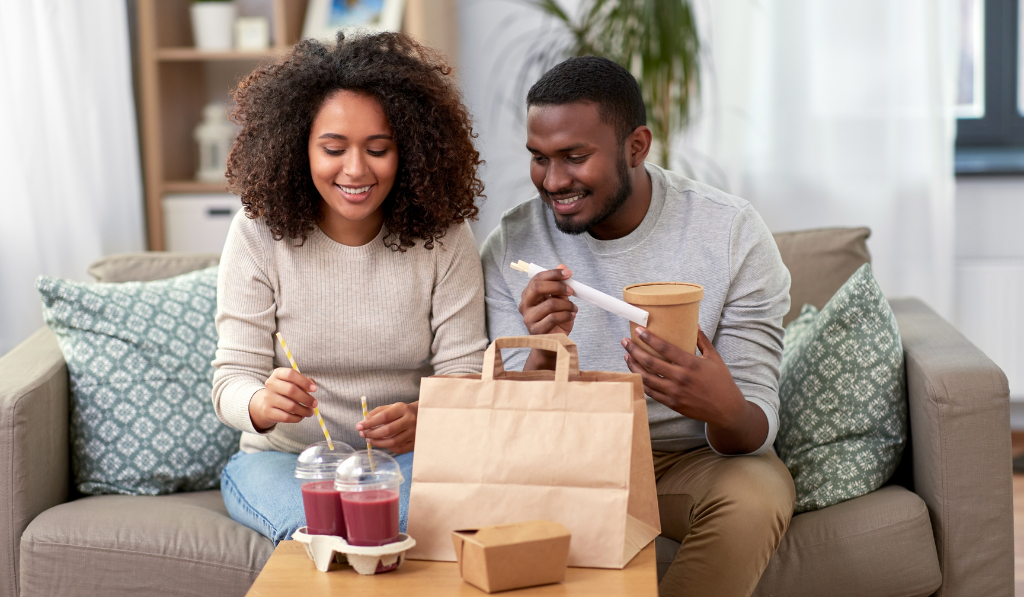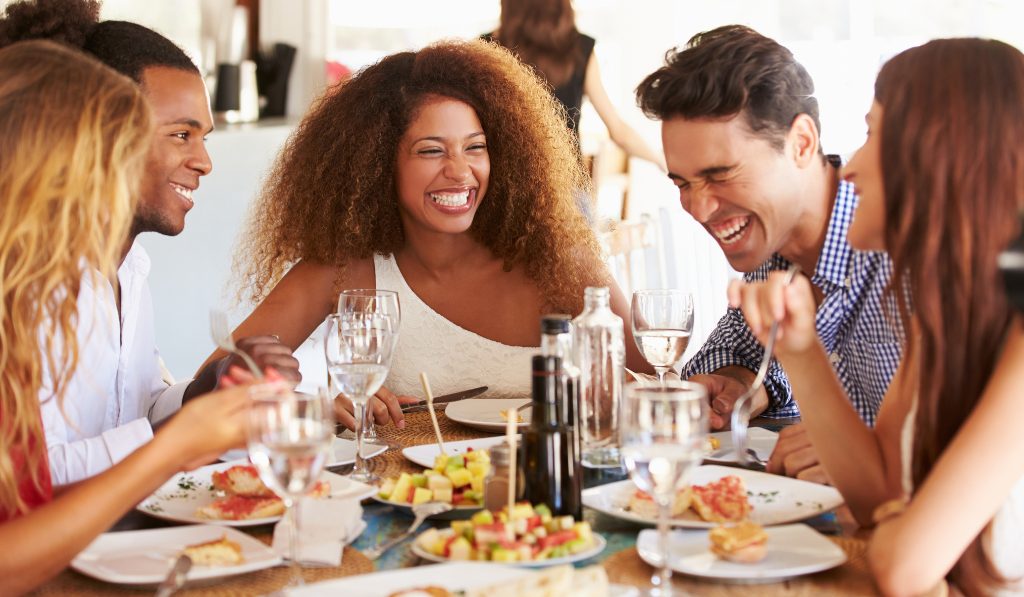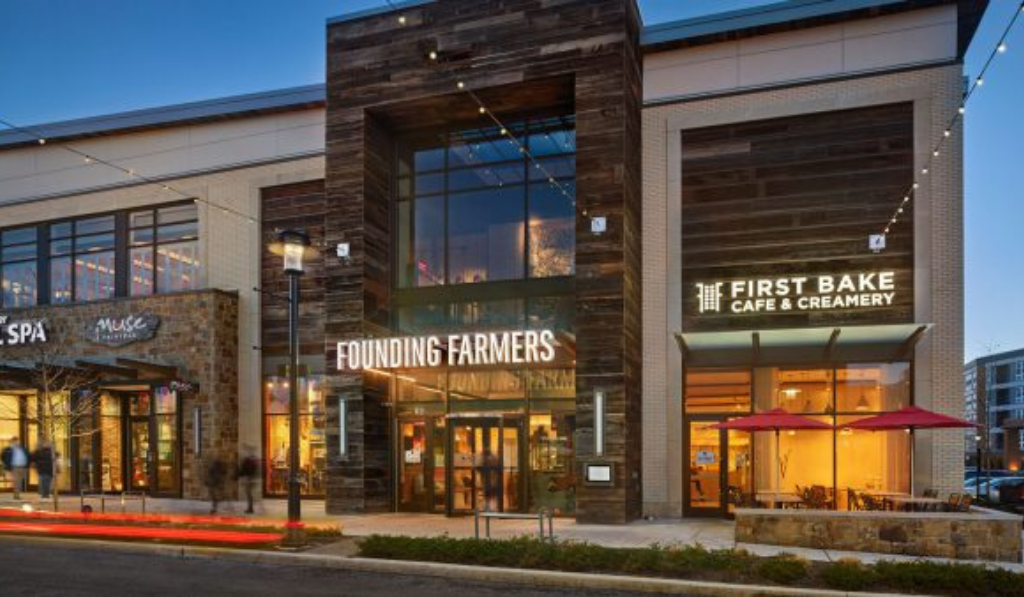The Restaurant of the Future: Blending the Tech and Touch in a Post-Covid World?

By Lydia Hanks, Ph.D., Flordia State University, Makarand Mody, Ph.D., Boston University School of Hospitality Administration, and Noah Katcher, Boston University
The way in which customers interact with restaurants is shifting rapidly, and the nature of the restaurant experience continues to evolve. The ubiquity of digital platforms has created unique opportunities for restaurants to engage their customers. Additionally, the concept of what constitutes a “restaurant experience” has grown and changed from a traditional dine-in or delivery model to a multi-channel user experience. As new restaurateurs create their offerings, and existing restaurants retool for business in the future, they must consider carefully how they design the customer experience.
We propose that the restaurant of the future must visualize customer experience design along two dimensions. The first dimension, represented by the Y axis in Figure 1 below, is the extent to which restaurant experience designers choose to leverage the human component of hospitality. The role of the human “touch”, i.e., hospitable service, in creating value in service organizations has been well-established, and it obviously behooves experience designers to equip employees to create interactions that enhance the customer experience. By the same token, other restaurant experiences, particularly in the QSR (quick service restaurants) and fast-casual sectors, emphasize speed and efficiency, and the human touch can actually detract from the customer experience.
Thus, we identify a continuum of high touch and low touch as one of the dimensions of designing effective restaurant experiences.
The second dimension, represented by the X axis in the figure below, is the extent to which restaurant experience designers choose to leverage the “tech” component of hospitality. In its modern manifestation, the tech dimension involves the principles of user experience (UX) design, i.e., identifying how customers (users) interact with the various “touchpoints” of the restaurant experience and optimizing UX to deliver experiences that are frictionless, customizable, and digitally engaging. These touchpoints could include the restaurant’s reservation channels, ordering and delivery touchpoints, billing and payment mechanisms, customer service and engagement applications, as well as content and discovery platforms. While Covid-19 has made technology applications a key part of most restaurants’ recovery toolkit (Malbec, 2020), we propose the need for a more holistic assessment of how customers interface with the restaurant brand (Haas, Kuehl, Moran, & Venkataraman, 2020).

In sum, of the two dimensions in our framework, the touch dimension represents the “softer” components of human hospitality, while the user experience dimension identifies the digital interactions that comprise customer touchpoints. The changing nature of restaurant interaction has evolved to an increasing emphasis on the user experience (UX), and this trajectory has been hastened by the Covid-19 pandemic. As restaurant owners reevaluate their concepts in a quickly changing environment, they will have to give serious consideration as to where on the continuums of “touch” and “user experience” they wish to be.
Low UX Experiences are Here to Stay
The 2X2 framework that we propose results in four restaurant archetypes: Food Functionalists, Food Artists, Food Factories, and Food Pioneers. On the low end of the UX axis, Food Functionalists are restaurant brands that provide utility to customers, but are highly functional, undifferentiated, and low on the human hospitality dimension. Your local Thai takeout restaurant is a good example of a Food Functionalist. Food Artists, on the other hand, design experiences that leverage the touch component of hospitality more extensively. Emphasizing an in-restaurant dining model, these restaurants rely on high customer service delivered by well-trained employees who embody qualities such as hospitableness, empathy, attentiveness, and reliability. Del Frisco’s is an example of a restaurant brand that qualifies as a Food Artist. Specializing in prime steaks and fine wines, Del Frisco’s Double Eagle Steakhouses go the extra mile of sending guests postcards hand-written by the server who attended to them, expressing gratitude for their visits and inviting them back to the restaurant. Food Functionalists and Food Artists are here to stay. There will undoubtedly always be Food Artists, providing exquisite culinary experiences, and Food Functionalists, providing quick, inexpensive, and low–touch meals.

High UX Restaurant Experiences for Changing Times
The addition of the user experience dimension to restaurant experience design, however, offers new and exciting opportunities for creating restaurant brands that appeal to today’s tech-savvy restaurant-goer. This dimension offers two additional archetypes: Food Factories and Food Pioneers. Food Factories are restaurant brands that offer low (human) touch, but high user experience interactions. The recent proliferation of ghost kitchens and brands offering only delivery and other in-home consumption options (such as meal kits) are exemplars of food factories. Brinkers International, parent company of Chili’s and Maggiano’s, created a delivery-only brand, virtually overnight, called “Its Just Wings.” The brand is estimated to generate sales of $150 million a year while using existing kitchen capacity of its dine-in brands (Maze, 2020). There is no physical storefront that customers can visit to get their wings, only the website and delivery apps on which the virtual brand is found.
Finally, Food Pioneers are restaurant brands that offer experiences that are high on touch and high on user experience. Pioneers also blur the boundaries between a traditional “restaurant experience” (dining-in, takeout, and delivery) and other consumption formats such as retail and virtual experiences. For example, during the Covid-19 pandemic, Boston-based Brato offered “hell night” chicken-wing meal kits with customers joining the event via Zoom, and Brato personnel walking them through the wing-eating process, explaining the nuances of each accompanying hot sauce (Doyle, 2020).

Components of a High UX Experience
One can infer that a great deal of future growth in the restaurant industry is likely to be due to the proliferation of Food Pioneers and Food Factories, the two segments characterized by an emphasis on high UX. The integration of technology into the restaurant experience is here to stay, and successful new restaurant concepts will embrace and leverage such technological advances. As the emphasis of the customer/restaurant encounter shifts from in-person to online and in-app, it is of paramount importance that these digital interactions are not just functional, but pleasurable and seamless. As restaurateurs conceptualize and develop their restaurants in the future, they will need to ensure that the user experience is frictionless, digitally engaging, and customizable.
A frictionless digital experience, from a restaurant customer’s point of view, is one that is high on time, convenience, and accuracy. The use of an app as compared to a phone call, for example, eliminates time on hold, allows the customer to peruse the menu at their leisure and place orders as they decide, and makes the repetition of addresses and phone numbers unnecessary, all of which save the customer time.
In the same vein, digital experiences are convenient. Users can explore a restaurant’s website, learn about its offerings, read reviews and descriptions, see pictures and videos, and place an order, all in one seamless encounter. The third component of a frictionless encounter is accuracy. The use of an app to place an order eliminates the human error component of orders placed by phone.
Restaurants of the future must be digitally engaging as well. In a traditional restaurant, customer engagement happened through the use of servicescape elements and human interactions (Hanks and Line, 2018). However, in a world where the interaction between the restaurant and the customer is increasingly happening online, these platforms must not only serve as an ordering platform, but also an engaging digital experience. Interactive menus, chef cooking videos, virtual tours, customer chat boards, and virtual live events are only a few of the elements that can be used to create an immersive, engaging digital experience for the restaurant customer of the future.
Finally, restaurant customers will be looking for a user experience that is customizable. This means that customers should be able to pick, choose, and combine the elements of the restaurant’s offerings to create an experience that suits their needs. The same customer, at different times, may wish to use the restaurant’s online platform to make reservations, order meal kits, join a virtual group wine class, order food for delivery, and send a gift box to a friend. For example, the James Restaurant in New York offers indoor and outdoor dining, a selection of groceries, baked goods and desserts, sweets and snacks, wine, specialty cocktail mixes, cooking-related retail items, meal kits, and gift cards (James Restaurant, 2021). This breadth of offerings allows patrons to customize their interactions with the restaurant and create a new and unique experience each time.
Mini Case Study: Farmers Restaurant Group

An excellent example of a restaurant company that offers a high level of user experience, one that is frictionless, engaging, and customizable, is Farmers Restaurant Group (FRG). Based in the Washington, DC region, FRG operates seven restaurants under four brands, in addition to an in-house distillery and bakery. Dan Simons, Founder and Co-Owner of FRG, notes that as the pandemic raged throughout the spring and summer of 2020, FRG needed a business model that could work under the newly formed health guidelines—a model that offered a high level of user experience (UX) and a low level of human contact. In addition, customer interactions had to be frictionless, engaging, and customizable in order for the group to continue offering the level of service that their customers were used to, in the absence of human interaction. To that end, Founding Farmers Market and Grocery was born. The company quickly developed its own e-commerce platform full of pre-made meals, produce, bakery items, and desperately-needed household items. Using their network in the restaurant landscape, the chain was able to have continued access to essential items that regular grocery stores simply couldn’t keep on their shelves.
FRG quickly realized the necessity of a frictionless UX experience. Contactless ordering and third-party food delivery applications are what drove revenue during this
time, and while FRG was already established on both UberEats and DoorDash, they added additional applications such as Caviar, Postmates, and Grubhub. However, this posed a unique challenge in the form of order synchronization. As these platforms were being introduced to FRG’s network, each application required the restaurant chain to have a specific iPad corresponding to the third-party delivery service. Then, a staff member would have to re-enter these orders into the existing restaurant point of sale (POS) system for communication with the kitchen. This led to glitches for the customer, order mistakes due to human error, and time delays. It was anything but frictionless. To solve this digital ordering issue, FRG introduced Olo, a platform that integrates all
third-party applications into the restaurant’s POS system. Olo eliminated the need for multiple tablets and streamlined the ordering process from the customer’s device to the FRG kitchens.
FRG was also aware of the crucial need to engage their customers through UX, as the pre-pandemic model of human engagement between customers and restaurant staff was severely limited. For those customers still dining in, FRG was quick to introduce QR codes, creating a low-touch but informative user experience. Banners were installed outside the front doors to their locations, allowing customers to engage with the menu before they entered the restaurant. They also revamped their existing website and added a website for Founding Farmers, both picture-heavy, full of stories and history, and interactively engaging (https://www.wearefoundingfarmers.com/).
Most importantly, the pivot required to meet the demands of the pandemic pushed FRG to make each customer’s experience more customizable than ever before. With the new changes in place, customers could choose from a restaurant, traditional groceries, fresh fruits and vegetables, prepared meals, household supplies, catering, fine spirits, fresh bakery items, and more. This breadth of offerings now results in a completely customizable experience for each customer, each time they interact with FRG. An individual has complete control over the level of contact, the type of purchase, the acquisition method, and the items purchased.
So, what was the key factor that allowed FRG to shift right on the X axis toward a higher UX, while continuously having to move up and down the Y axis as various levels of human touch were mandated by the pandemic, and thus emerge as a stronger, more
successful company? According to Simons, it was company culture. He notes that FRG “was successful navigating the pandemic through many measures because before the pandemic, we knew who we were, understood our purpose, mission, and were a principle centered group… it was a story of a team bound together by a culture.”
Conclusion
Our framework demonstrates that there is no one-size-fits-all approach. While there may be a temptation to design restaurants of the future with a high UX and remove the human component (creating Food Factories), restaurants of all types are likely to find a place in a post-Covid world. Even Food Functionalists can have high emotional resonance with customers, providing a sense of comfort, assurance, stability, and simplicity in an increasingly complex world. Similarly, Food Artists are here to stay, contributing innovation, talent, and exquisite service to the industry, and Food Pioneers stand to create customer engagement through their hands-on, technologically-enabled provision of multi-channel customer interactions. The aspirations and motivation of the owner, the culture of the company, the needs and wants of the target market, and market trends (both technology and food-related) should drive the adoption of our framework, helping owners streamline and clearly define their place within that framework, as well as their unique proposition.
Owners can use this framework to determine where on the grid they wish to be as a restaurant entity. Doing so will help inform their decision-making as to where and how to invest their dollars, whether it be in buildings, people, technology, or a blend of all three. Owners must design not just an eating experience, but a restaurant brand, in order to stay competitive in the future. Drawing on branding principles from product companies and other industries, restaurateurs can learn how to create meaningful brands through various customer interfaces, both interpersonal and digital. As the nature of the restaurant experience continues to evolve, the mechanisms by which people connect with a restaurant may change, but their relationship with the brand will remain constant.
References
9 comments
Every year thousand of up-and-comers give the test for Cisco 300-410 test dumps yet just not many clear their path through the 300-410 pdf dumps test. This is on the grounds that finishing the test doesn’t just need arrangement and advancing however it likewise requires proficient Cisco 300-410 dumps to advance. For this 300-410 test dumps reason, Exactinside has the best quality, legitimate and most solid Implementing Cisco Enterprise Advanced Routing and Services 300-410 dumps to provide food your test needs. By planning through the 300-410 inquiries dumps material given by Exactinside you will doubtlessly clear your test in one go as it is the most legitimate and engaging 300-410 test dumps material arranged by specialists.
Visit Page: https://www.exactinside.com/300-410-exactdumps.html
Its a great pleasure reading your post. Its full of information
talk to astrologers
hese restaurants are focused on creating a unique and memorable dining experience. They typically betterfleet have a strong focus on food quality, and they often use creative and innovative techniques to prepare their food.
If you like playing sports, https://basketballstarsunblocked.io is for you. Join in the game and conquer the best prize
Hello. Recently I was arguing with a friend about the best bookmaker. After a long argument, he agreed that melbetnp.app is the best bookmaker. That’s why I want to recommend it to you, because it has gained not only my and my friend’s trust but also the trust of millions around the world! If you want to place bets, then this site is for you!
Discover the epitome of elegance with best attar for women from Hemani Fragrance. Our exquisite blends are crafted to accentuate femininity and grace, leaving a lasting impression wherever you go. Embrace your individuality with our luxurious attar collection
The evolving landscape of restaurant experiences, as outlined in this article, underscores the importance of embracing both human touch and digital innovation. It’s fascinating to see how restaurants adapt to meet changing consumer needs. For those interested in further exploring the intersection of technology and hospitality, check out ZonHack’s insightful blog on SEO and digital marketing: https://zonhack.com/
This article presents a compelling framework for understanding the evolving landscape of restaurant experiences. It’s fascinating to see how the intersection of human touch and tech creates diverse opportunities. For those interested in enhancing their restaurant’s digital presence, OutreachNeo’s blog on SEO and digital marketing is a valuable resource. Check it out here: https://outreachneo.com/
And we opened our restaurant in Toronto last week. Just finished work on the incoming group. We ordered very nice railings through https://prorailings.com/ , the design of the restaurant was also designed by experienced specialists. Therefore, everything turned out very cool